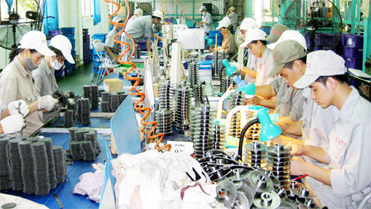INDOCHINA INTERNATIONAL CONSULTING CO., LTD
HO Add: 62L/36 Nguyên Hồng, Ward 11, Bình Thạnh District, HCMC - Vietnam
Biz Office Add: #48 Road No 11, Quarter 6, Hiệp Binh Chánh Ward, Thủ Đức, HCMC - Vietnam
®Source: http://viipip.com should be clearly quoted for any use of information extracted from our website.
Publication permit No: 60/GP-TTĐT , April 05, 2010.


Hình ảnh minh họa
Governor of the State Bank of Vietnam (SBV) Nguyen Van Binh, in an interview given to Bloomberg, said that the bank would release a circular on auctioning VAMC’s assets and a circular on handling with mortgaged assets.
This would serve as the important legal framework for VAMC to sell the bad debts and mortgaged assets. Once the laws can create more favorable conditions for Vietnamese banks, VAMC and investors to trade debts and assets, this would help speed up the bad debt resettlement process.
In the interview, the Governor emphasized that the government of Vietnam and SBV welcome foreign investors’ participation in the debt resettlement process in Vietnam.
How far has the debt settlement process gone?
A debt trading company, VAMC, was established in 2013, an important move in the debt resettlement path. To date, VAMC has reportedly bought the huge sum of bad debts worth VND40 trillion from commercial banks.
Meanwhile, commercial banks have been told to strictly follow the SBV’s regulations on making provisions against the risks for loans.
According to Dao Minh Tu, Deputy Governor of SBV, in 2014, the central bank would focus on helping banks handle with their debts and prevent new bad loans, while striving for the healthy finance situation for banks.
However, the bad debt resettlement still cannot go far. A recent report of the State Bank showed that the bad debt ratio of the whole banking system had reached 3.63 percent by the end of 2013. And if counting on the bad debts which have been restructured in accordance with the Decision No 780, the ratio would be 9 percent.
Meanwhile, a report released by Moody’s in late February 2014 affirmed that the bad debt ratio of the Vietnamese banking system had reached 14 percent by that time.
The high bad debt ratio could be the main reason that forced SBV to delay the implementation of the regulations on restructuring the debt payment deadlines and keep intact the groups of bad debts until April 1, 2015.
The move by the State Bank aims to give commercial banks more time to “tidy up” their bad debts, or their bad debt ratios would soar.
One more tool to help clear debts
In order to make the debt market more bustling, it is necessary to create the tool for the asset auctioning.
The tool can be used in case borrowers cannot pay debts or resume their production and business, according to Binh. If so, VAMC would sell the debts and the collaterals. VAMC would also consider buying bad debts in the market if it has suitable conditions to do this.
Commenting about the information, Nguyen Quoc Hung, Deputy Chair of VAMC, said the move would facilitate VAMC’s activities of trading debts and selling assets.
Hung went on to say that VAMC hopes the circular can come out soon. However, he said he still does not feel absolutely satisfactory with the draft circular, which says that auctions will be held to sell the assets valued at less than VND10 billion.
- FDI capital continues to pour into Vietnam (6/11/2025 1:20:33 PM)
- Thanh Hoa receives good news: Preparing to have an additional industrial park of up to 470 hectares, creating jobs for nearly 30,000 people (6/11/2025 1:15:09 PM)
- Industrial Park Real Estate: Waiting for the New Generation of FDI (6/11/2025 1:10:15 PM)
- A wealthy Vietnamese city will have two special economic zones after the merger (6/11/2025 1:04:42 PM)
- 30 billion USD capital FDI in Việt Nam by 2025, a series of "ông big" races to expand the land fund (6/11/2025 12:55:26 PM)
- the 2nd largest city in the North will start construction on an international economic zone (6/11/2025 12:50:20 PM)
- Japanese giant Sumitomo continues to want to build an industrial park in the countrys fourth smallest province. (6/11/2025 12:40:45 PM)
- 3 foreign corporations want to invest billions of dollars in Ba Ria - Vung Tau (6/11/2025 12:34:30 PM)
- Lotte Group member starts construction of nearly 1,000 billion VND logistics center in the province with the most industrial parks in Vietnam (6/11/2025 12:33:26 PM)
- Forming a regional center for manufacturing spare parts and components (6/11/2025 12:24:08 PM)
- Vietnams first wafer factory is about to start construction (6/11/2025 12:19:09 PM)
- Dong Nai attracts foreign investors (6/11/2025 12:13:27 PM)
- Tay Ninhs largest industrial park welcomes a $150 million high-end knitted fabric factory project (6/11/2025 12:11:00 PM)
- (6/11/2025 12:09:10 PM)
- Vietnam will become a destination for Chinese investors in the future (11/6/2023 1:03:19 PM)

- FDI capital continues to pour into Vietnam
- Thanh Hoa receives good news: Preparing to have an additional industrial park of up to 470 hectares, creating jobs for nearly 30,000 people
- Industrial Park Real Estate: Waiting for the New Generation of FDI
- A wealthy Vietnamese city will have two special economic zones after the merger
- 30 billion USD capital FDI in Việt Nam by 2025, a series of "ông big" races to expand the land fund










 ADB: Vietnam’s 2009 GDP growth to be highest in South East Asia
ADB: Vietnam’s 2009 GDP growth to be highest in South East Asia MGM Grand Ho Tram: Vietnam’s First ‘Las Vegas Style’ Integrated Resort
MGM Grand Ho Tram: Vietnam’s First ‘Las Vegas Style’ Integrated Resort Nha Trang’s Twin Towers project licenced
Nha Trang’s Twin Towers project licenced Foreign investors still have good opportunities in Vietnam
Foreign investors still have good opportunities in Vietnam Sierra Wireless gets a foot in Vietnam’s ICT market
Sierra Wireless gets a foot in Vietnam’s ICT market